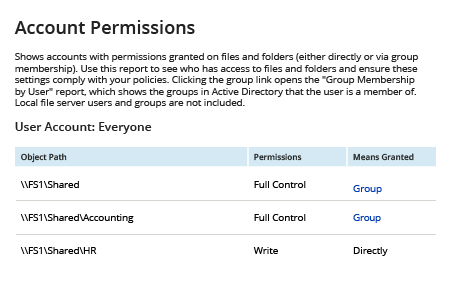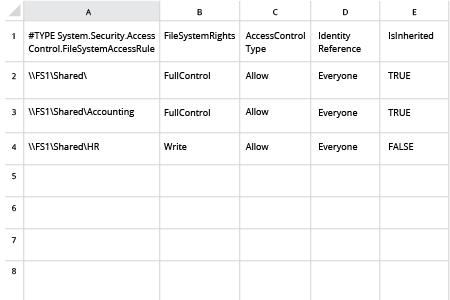Comment lister les permissions du groupe Everyone
Netwrix Auditor pour Windows File Servers
- Exécutez Netwrix Auditor → Cliquez sur « Rapports » → Choisissez « Serveurs de fichiers » → Développez « État des serveurs de fichiers à un moment donné » → Choisissez « Permissions de compte » → Cliquez sur « Afficher » → Spécifiez le partage de fichiers » → Cliquez sur « Voir le rapport ».

Audit Natif
- Pour lister les permissions du groupe Everyone dans le système de fichiers NTFS, exécutez le script suivant dans PowerShell, en spécifiant les valeurs appropriées pour les paramètres "Network File Share Path" et ".csv File Name And Path".
dir -Recurse | where { $_.PsIsContainer } | % { $path1 = $_.fullname; Get-Acl $_.Fullname | % { $_.access | where { $_.IdentityReference -like "everyone" } | Add-Member -MemberType NoteProperty -name "Network File Share Path" -Value $path1 -passthru }} | export-csv ".csv File Name And Path”
- Ouvrez le fichier .csv créé dans Microsoft Excel et vérifiez à quels dossiers partagés le groupe Tout le monde a des droits d'accès.

L'importance de contrôler les permissions du groupe “Everyone”
Les attaques externes ne sont pas la seule cause de violations de sécurité. Des pratiques telles que l'octroi de permissions NTFS au groupe « Tout le monde » ou l'assignation de permissions directement au lieu de passer par l'appartenance à un groupe peuvent permettre aux employés et autres utilisateurs internes d'accéder à des données auxquelles ils ne devraient pas avoir accès, y compris potentiellement des données sensibles. Et si le groupe « Tout le monde » a un accès total à quelque chose, tous les comptes utilisateurs authentifiés par Active Directory peuvent copier, distribuer, lire, modifier et supprimer des fichiers — et il en va de même pour tous les comptes anonymes et invités qui sont membres du groupe Tout le monde. Cela peut conduire à la corruption, l'exfiltration ou la perte de données, ainsi qu'à des violations de la confidentialité des données. Pour réduire ces risques, les administrateurs système devraient régulièrement réviser les permissions de partage accordées au groupe « Tout le monde », ainsi que toutes les permissions qui ont été accordées directement.
Netwrix Auditor for Windows File Servers offre une visibilité complète sur l'activité des utilisateurs et sur qui a accès à quoi à travers vos serveurs de fichiers basés sur Windows. Les rapports d'état à un moment donné fournissent des détails exploitables sur quels utilisateurs du domaine ont accès à quels fichiers et indiquent si les permissions ont été accordées directement ou via l'appartenance à un groupe AD. Grâce à ces informations, les professionnels de l'informatique peuvent facilement détecter les permissions accordées au groupe « Everyone » et éliminer ces propriétés pour réduire le risque de fuites de données et améliorer la sécurité des données dans leur environnement informatique.
Partager sur
